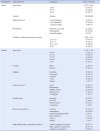Abstract
Purpose
This study was undertaken to identify which delirium screening instrument would be more useful in clinical practice.
Methods
Data were collected from 118 nurses from six hospitals in five provinces in Korea. For the delirium screening three instruments were compared: NEECHAM Confusion Scale (NEECHAM), Nursing Delirium Screening Scale (Nu-DESC), Delirium Observation Scale (DOS). The MMSE-K was used for concurrent validity. The nurse subjects were surveyed as to the practical clinical value of each instrument. Cronbach's α coefficient and Kuder-Richardson 20 were used to confirm the reliability.
Results
The range of three scales reliability was .70~.82 and the range of correlation coefficient was .63~.82 with MMSE-K. For sensitivity of NEECHAM, Nu-DESC and DOS was 1.00, 1.00 and 0.81 respectively and specificity NEECHAM, Nu-DESC and DOS was 0.88, 0.89 and 0.89 respectively. Nurses rated the practical use of the DOS scale as significantly easier to use than the NEECHAM and Nu-DESC.
Figures and Tables
References
1. Adamis D, Sharma N, Whelan PJ, Macdonald AJ. Delirium scales: A review of current evidence. Aging Ment Health. 2010; 14:543–555. DOI: 10.1080/13607860903421011.

2. Champagne MT, Neelon VJ, McConnel ES, Funk S. The NEECHAM Confusion Scale: Assessing acute confusion in hospitalized and nursing home elderly. Gerontologist. 1987; 27:Supplement 4A.
3. Duppils GS. Predictive value and validation of the NEECHAM confusion scale using DSM-IV criteria for delirium as gold standard. Int J Older People Nurs. 2011; 6(2):133–142. DOI: 10.1111/j.1748-3743.2010.00232.x.
4. Folstein MF, Folstein SE, Mchugh PR. Mini-Mental State: A practical method for grading the cognitive state of patient for the clinician. J Psychiatry Res. 1975; 12:189–198. DOI: 10.1016/0022-3956(75)90026-6.
5. Foreman MD, Zane D. Nursing strategies for acute confusion in elders. Am J Nurs. 1996; 96(4):44–52.

6. Gaudreau JD, Gagnon P, Harel F, Tremblay A, Roy MA. Fast, systematic, and continuous delirium assessment in hospitalized patients: The nursing delirium screening scale. J Pain Symptom Manage. 2005; 29(4):368–375. DOI: 10.1016/j.jpainsymman.2004.07.009.

7. Gemert van L, Schuurmans MJ. The Neecham confusion scale and the delirium observation screening scale: Capacity to discriminate and ease of use in clinical practice. BMC Nurs. 2007; 6(3):1–6. DOI: 10.1186/1472-6955-6-3.

8. Grover S, Kate N. Assessment scales for delirium: A review. World J Psychiatry. 2012; 2(4):58–70. DOI: 10.5498/wjp.v2.i4.58.

9. Han MI. Clinical approach to delirium in elderly patients. J Korean Geriatr Psychiatry. 2004; 8:96–101.
10. Inouye SK. The confusion assessment method (CAM): Training manual and coding guide. New Haven: Yale University School of Medicine;2003.
11. Inouye SK, Foreman MD, Mion LC, Katz KH, Cooney LM. Nurses' recognition of delirium and its symptoms: comparison of nurse and researcher ratings. Arch Intern Med. 2001; 161:2467–3473. DOI: 10.1001/archinte.161.20.2467.
12. Kim EJ, Park YK. SPSS statistical analysis 8. Seoul: 21Saegi Co;2000.
13. Kim KN, Kim CH, Kim KI, Yoo HJ, Park SY, Park YH. Development and validation of the Korean nursing delirium scale. J Korean Acad Nurs. 2012; 42:414–423. DOI: 10.4040/jkan.2012.42.3.414.

14. Kwon YC, Park JH. Korean version of Mini-Mental State Examination (MMSE-K) part I: Development of the test for the elderly. J Korean Neuropsychiatr Assoc. 1989; 28:125–135.
15. Lee EH, Jung YH, Kim JS, Song RY, Hwang KY. Statistical methods for health care research. Seoul: Kunja Publishing;2002.
16. Lee YW, Kim CG, Kong ES, Kim KB, Kim NC, Kim HK, et al. A study of nurses' knowledge level and assessment experience of delirium. J Korean Acad Adult Nurs. 2007; 19:35–44.
17. Matarese M, Generoso S, Ivziku D, Pedone C, Marinis MG. Delirium in older patients: A diagnostic study of Neecham confusion scale in surgical intensive care unit. J Clin Nurs. 2012; 11. 22. 26:1–9. on-line published. DOI: 10.1111/j.1365-2702.2012.04300.x.

18. McCarthy M. Detecting acute confusion in older adults: Comparing clinical reasoning of nurses working in acute, long-term, and community health care environments. Res Nurs Health. 2003; 26:203–212. DOI: 10.1002/nur.10081.

19. Neelon VJ, Champagne MT, Carlson JR, Funk SG. The NEECHAM Confusion Scale: Construction, validation, and clinical testing. Nurs Res. 1996; 45:324–330.

20. Park JH, Kwon YC. Standardization of Korean version of the Mini-Mental State Examination (MMSE-K) for use in the elderly. Part II. Diagnostic validity. J Korean Neuropsychiatr Assoc. 1989; 28:508–513.
21. Polit D, Beck C, Hungler B. Essential of nursing research: methods, appraisal and utilization. Philadelphia: Lippincott;2001.
22. Rapp CG, Wakerfield B, Kundarat M, Mentes JC, Tripp-Reimer T, Culp K, et al. Acute confusion assessment instruments: Clinical versus research utility. Appl Nurs Res. 2000; 13:37–45. DOI: 10.1016/S0897-1897(00)80017-8.
23. Rompaey BV, Schuurmans MJ, Shortridge-Baggett LM, Truijen S, Elseviers M, Bossaert L. A comparison of the CAM-ICU and the NEECHAM confusion scale in intensive care delirium assessement: An observational study in non-intubated patients. Crit Care. 2008; 12:1–7. DOI: 10.1186/cc6790.
24. Shuurmans MJ, Donders RT, Shortridge-Baggett LM, Duursma SA. Delirium case finding: Pilot testing of a new screening scale for nurses. J Am Geriatric Soc. 2002; 50(4):S3.
25. Shuurmans MJ, Shortridge-Baggett LM, Duursma SA. The Delirium Observation Screening Scale: A screening instrument for delirium. Res Theory Nurs Pract. 2003; 17(1):31–50.

26. Trzepacz PT, Meagher DJ, Wise MG. Neuropsychiatric aspects of delirium. In : Yudofsky SC, Hales RE, editors. Textbook of neuropsychiatry and clinical neurosciences. Washington DC: American Psychiatric Publishing Inc;2002. p. 534–564.
27. Wakerfield BJ. Risk for acute confusion on hospital admission. Clin Nurs Res. 2002; 11:153–172. DOI: 10.1177/10547738020110205.

28. Yu MY, Park JW, Hyun MS, Lee YJ. Factors related to delirium occurrence among the patients in the intensive care units. J Korean Clin Nurs Res. 2008; 14:151–160.




 PDF
PDF ePub
ePub Citation
Citation Print
Print





 XML Download
XML Download